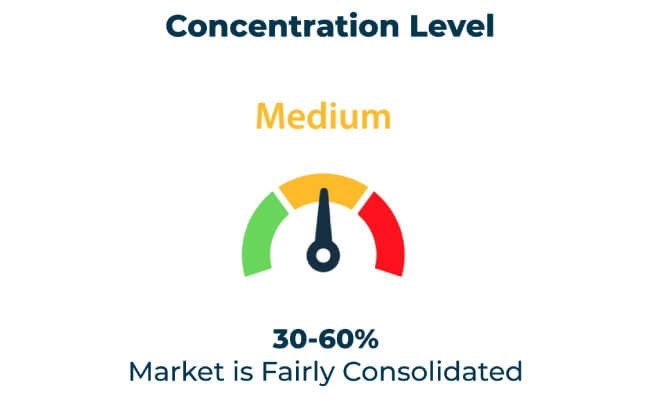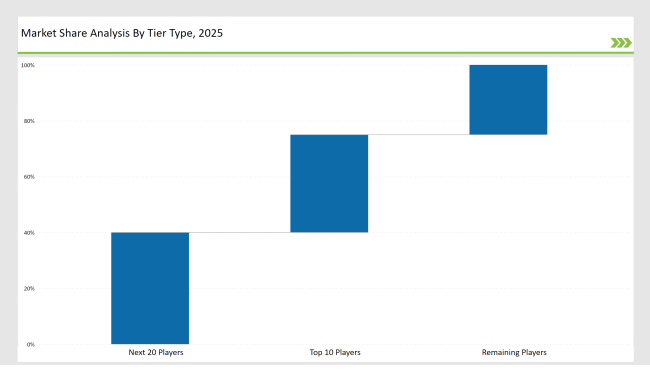The global braille labels market is highly competitive, with companies categorized into Tier 1, Tier 2, and Tier 3 based on market presence and strategic positioning. Tier 1 players, including Avery Dennison, 3M, and CCL Industries, collectively hold 35% of the market. These companies dominate by leveraging advanced printing technology, compliance with accessibility regulations, and strong distribution networks to meet the increasing demand for braille labeling solutions.
Tier 2 players, such as UPM Raflatac, Schreiner Group, and Multi-Color Corporation, account for approximately 40% of the market. They focus on cost-effective, customizable braille label solutions for pharmaceutical, food, and consumer goods packaging. These players strengthen their market presence by expanding production capacities and enhancing smart labeling technologies.
Tier 3 players, including regional manufacturers and niche startups, hold 25% of the market. They specialize in unique braille printing techniques, lightweight label materials, and compliance-driven labeling solutions. Their agility enables them to quickly adapt to changing accessibility regulations and market needs.
Exclusive Offer: 30% Off on Regional Reports
Get a free sample report and customize your regions for a 30% discount on your regional report!
Global Market Share by Key Players (2025)
| Category | Market Share (%) |
|---|---|
| Top 3 (Avery Dennison, 3M, CCL Industries) | 18% |
| Rest of Top 5 (UPM Raflatac, Schreiner Group) | 10% |
| Next 5 of Top 10 (Multi-Color Corporation, Denny Bros, Tactile Labels, MCC Label, Rotomail) | 7% |

The braille labels market serves industries such as
Vendors offer specialized products to meet evolving industry needs
Manufacturers integrate automation, AI-driven printing quality control, and compliance-driven innovations to enhance efficiency while accessibility regulations remain a key driver for market growth.
This section highlights the key players that led innovation and growth in the braille labels market in 2025. Companies introduced high-performance, durable braille labels to improve accessibility. Manufacturers invested in AI-driven quality control to enhance efficiency. Firms expanded production capacity to meet the increasing demand for regulatory-compliant braille labeling. Businesses developed smart labeling technologies to improve consumer engagement and traceability.
Year on Year Leaders
Check Free Sample Report & Save 40%!
Select your niche segments and personalize your insights for smart savings. Cut costs now!
| Tier Type | Example of Key Players |
|---|---|
| Tier 1 | Avery Dennison, 3M, CCL Industries |
| Tier 2 | UPM Raflatac, Schreiner Group, Multi-Color Corporation |
| Tier 3 | Denny Bros, Tactile Labels, niche startups |

| Manufacturer | Latest Developments |
|---|---|
| Avery Dennison | In January 2024, launched high-durability and eco-friendly braille labels. |
| 3M | In March 2024, introduced AI-powered quality control for braille embossing. |
| CCL Industries | In June 2024, expanded production capacity for smart braille labeling solutions. |
| UPM Raflatac | In February 2024, developed high-precision tactile labels with smart tracking. |
| Schreiner Group | In July 2024, launched braille labels with integrated NFC and digital accessibility. |
| Multi-Color Corporation | In April 2024, focused on compliant and durable braille labeling solutions. |
| Denny Bros | In August 2024, expanded European production to support regulatory compliance demands. |
The industry is evolving with AI-driven production monitoring, sustainable materials, and customized tactile solutions. Manufacturers optimize energy-efficient processes to reduce environmental impact. Companies invest in regulatory-compliant embossing techniques and mono-material braille labels for recyclability.
Engineers develop tamper-proof and highly durable braille labels for improved consumer usability. Firms enhance digital branding capabilities for interactive and accessible packaging. Emerging innovations will drive further investments in next-generation braille label technologies.
Avery Dennison, 3M, CCL Industries, UPM Raflatac, and Schreiner Group lead the market.
Tier-1 players collectively hold about 35% of the global market.
AI-based quality control, sustainable materials, and regulatory compliance drive innovation.
They enhance inclusivity, improve product differentiation, and comply with global accessibility regulations.
Smart packaging integrates NFC, QR codes, and digital accessibility for enhanced consumer engagement.
Explore Tech in Packaging Insights
View Reports
Thank you!
You will receive an email from our Business Development Manager. Please be sure to check your SPAM/JUNK folder too.